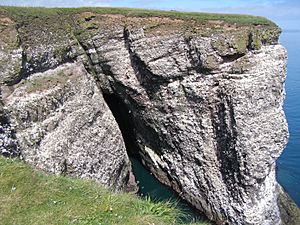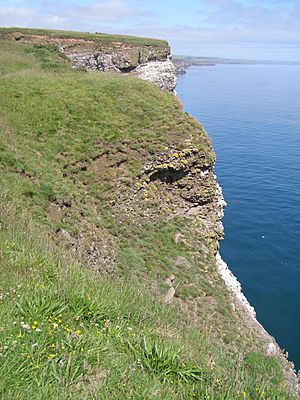Fowlsheugh facts for kids
Fowlsheugh is a special place on the coast of northeast Scotland. It is a nature reserve known for its tall cliffs, which are about 70 meters (230 feet) high. These cliffs are home to many seabirds that come here to build their nests. Fowlsheugh is protected by Scottish Natural Heritage and owned by the Royal Society for the Protection of Birds.
You can visit Fowlsheugh by walking along a path on top of the cliffs. You can also take a boat from the nearby harbour in Stonehaven. Every spring, thousands of birds return to Fowlsheugh to breed. They spend their winters at sea or in warmer places. Some of the main birds you will see are puffins, razorbills, kittiwakes, fulmars, and guillemots.
Sadly, global warming is affecting the tiny sea creatures called plankton. These creatures prefer cold water. Because of this, there are fewer sandeels, which are a main food source for puffins and other seabirds. Also, too much overfishing of sandeels has made the problem worse.
Contents
Cliffs and Rocks
The tall cliffs at Fowlsheugh are shaped by the strong waves of the North Sea and powerful winds. In some places, the cliffs even hang over the path. Winds here can be very strong, especially in winter. The main rock type is called Old Red Sandstone. This sandstone can be found from Dunnottar Castle in the north to the town of Catterline in the south. It can be very thick, up to 2700 meters (8,860 feet).
In some areas, the red and green sandstone mixes with a rock called conglomerate. This rock has round stones inside it, like a "puddingstone". You might also see greenish parts in the cliffs. These are harder rocks from old volcanoes.
At the bottom of the cliffs, where they meet the North Sea, there are several sea caves. You can only reach these caves by small boat. One cave, called the “Gallery,” goes 100 meters (330 feet) under the land. At the northern end of Fowlsheugh, there are two rocky islands called skerries. They are named Craiglethy and Gull Craig. These smaller islands are part of the reserve. They are also home to seabirds and a few harbour seals. You can sometimes see the seals resting on Craiglethy on sunny days.
A Look Back in Time
People have known Fowlsheugh was a special bird area for at least 500 years. Today, it is known as an Important Bird Area (IBA) and a Special Protection Area (SPA). We have good records of bird numbers from the last 100 years.
In the early Victorian times, a writer named James Anderson described Fowlsheugh. He said it was a "remarkable rock" about a mile long and 200 feet high. He noted that many seabirds, especially kittiwakes, came there to lay their eggs in the cracks of the rocks.
In the 1800s, people would visit Fowlsheugh to hunt seabirds. Some brave rock climbers would even rappel down the steep cliffs to collect the valuable seabird eggs. They would use ropes to go down, similar to how people collected eggs on Saint Kilda. The cliffs also have sandy soil, which is perfect for rabbits to dig their burrows. Puffins sometimes share these burrows when they are at Fowlsheugh.
Around the year 1900, the Crown allowed fishing near the cliffs. Fishermen used large nets, which accidentally caught many guillemots. This caused many birds to die and made the public very upset. So, the fishing was stopped the next year. In 1920, fulmars arrived at Fowlsheugh to breed, coming all the way from St. Kilda.
Protecting Fowlsheugh
Fowlsheugh is important because of its large seabird colonies. On August 31, 1992, it was given Special Protection Area (SPA) status. The reserve is about 10 hectares (25 acres) in size. This means it has one of the highest numbers of seabirds per area in Europe.
Birdlife and Reproduction
At the busiest time of the breeding season, between April and July, more than 170,000 birds live at Fowlsheugh. This makes it the second largest seabird colony in Britain. Most of the birds are auks and gulls. They find food in the nearby North Sea waters. Many birds build their nests on the steep cliffs. During breeding season, the cliffs are full of birds flying, landing, and feeding in the water below. It can get quite noisy!
In 2005, about 18,000 pairs of kittiwakes returned to Fowlsheugh to breed. They build their nests from mud, seaweed, and grass on the steepest parts of the cliffs. This number was lower than in 1992, when there were almost 35,000 pairs. From the cliff paths, you can easily watch the parent birds feeding their chicks.
In 1992, there were over 40,000 pairs of guillemots breeding here. Smaller numbers of other seabirds also nest at Fowlsheugh. These include puffins, razorbills, herring gulls, and fulmars. Sometimes, a peregrine falcon will fly by, scaring the nesting kittiwakes. You can also find smaller numbers of lesser black-backed gulls, great black-backed gulls, and common shags.
Marine Life

In the North Sea waters at the bottom of the cliffs, you can find different sea mammals. These include the common seal and the grey seal. As mentioned, seals can be seen resting on the rocky island of Craiglethy in summer. Further out at sea, you might spot dolphins.
The waters also have many types of fish. These include Atlantic shad, Atlantic salmon, and brown trout. Different kinds of seaweed also grow just offshore at Fowlsheugh.
Plants and Other Animals
On top of the cliffs, you will find many different flowering plants and grasses. These plants help support the large numbers of butterfly populations at Fowlsheugh. Most of these plants bloom between April and August. Some common flowering plants here are yarrow, sneezewort, spiked sedge, carline thistle, tall fescue, common osier, elder, and common rock-rose. The common rock-rose is very important because it is the only plant where the northern brown argus butterfly lays its eggs. Some plants grow on the rough cliff faces, while most grow on the rich soil at the top. This soil is also used for farming barley and other grains, and for sheep and cattle to graze.
Many types of butterfly live at Fowlsheugh, such as:
- Small tortoiseshell
- Dark green fritillary
- Northern brown argus (a very important species in the UK)
- Small heath
- Scotch argus
- Grayling (another important species that has been decreasing)
- Small copper
- Meadow brown
- Large white
How to Visit
The easiest way to get to Fowlsheugh Nature Reserve is to walk from the small village of Crawton. Crawton is about one kilometer (0.6 miles) east of the A92 coast highway and is well signposted. There is a small carpark near the start of the trailhead, but it has limited space for larger vehicles. You can access the walking trail at any time, and there is no cost to use it.
If you prefer to go by boat, you can take trips from Stonehaven Harbour. These boat trips are available from May to July for a small fee. They will take you to the base of the Fowlsheugh cliffs and even into some of the sea caves.
See also
 In Spanish: Fowlsheugh para niños
In Spanish: Fowlsheugh para niños





